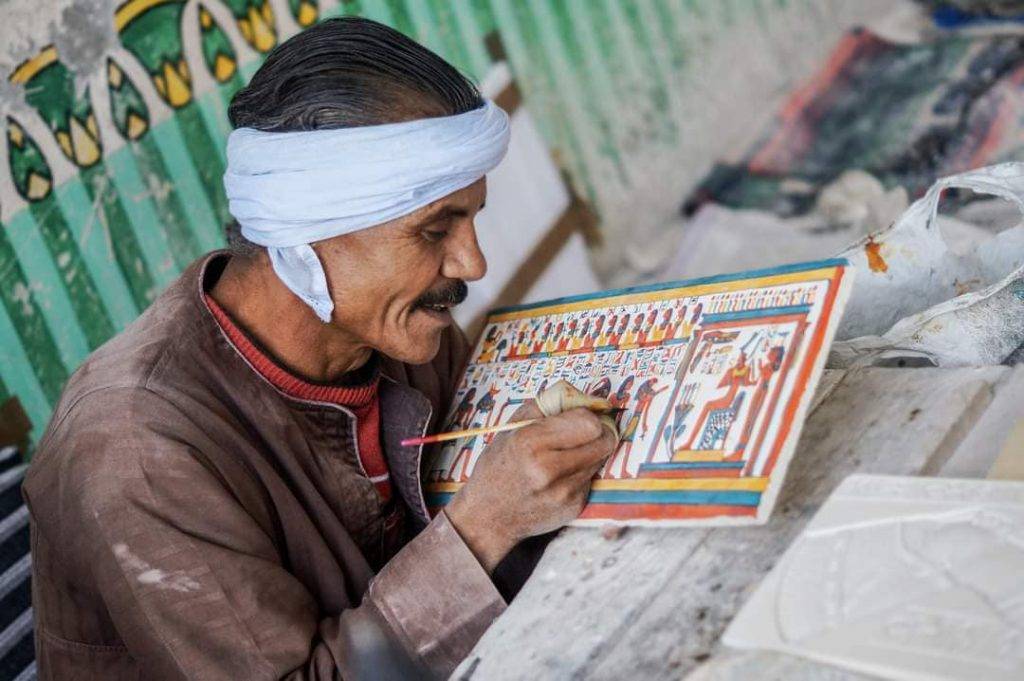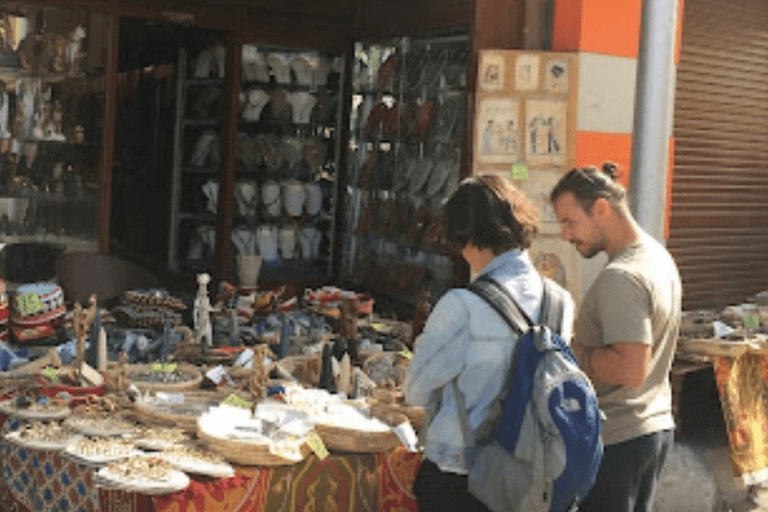Craft Traditions in Luxor
egypt crafts
Luxor, Egypt, is rich in history, but it is also a vibrant place where artists craft with alabaster, clay, and thread. In addition to famous sites like Karnak and the Valley of the Kings, the workshops in Qurna, and the West Bank are busy making carved stone, woven textiles, and pottery. These crafts have roots in ancient Egypt and showcase the culture, strength, and identity of the people, connecting Luxor’s rich history to its lively present.

The Heart of Luxor’s Crafts
Crafts are an important part of life in Luxor, connecting history, community, and creativity. In villages like Qurna, artisans turn raw materials into beautiful and useful objects, using skills they’ve learned from their ancestors. For many, crafting is not only a job but also a source of pride. “My father taught me to carve alabaster, just like his father taught him,” says Mahmoud, who is a third-generation artisan from Qurna. “Each piece tells our story.”
However, these traditions are under threat. Mass-produced souvenirs fill markets and compete with handmade goods. An article in Egypt Today points out more challenges: fewer young people are learning these skills, and changing tourism affects artisans’ incomes. Travel vlogger Explores, “Luxor’s Hidden Gems: Artisans at Work,” emphasizes the importance of these crafts: “These items aren’t just products; they’re part of Egypt’s soul.” Supporting artisans helps preserve both culture and community.
Luxor Tours & Activities
Looking to save some costs on your travel? Why not join a shared group tour to explore Luxor, Egypt? Here are some activities you might be interested in:

Alabaster Carving: Light in Stone
Alabaster has a soft glow and creamy colors that have attracted craftspeople since ancient Egypt. In Qurna’s workshops, artisans carve raw stone into vases, lamps, and sphinxes using traditional tools that have not changed for centuries. “When I carve, I feel the stone speak,” they say, her hands covered in dust. The rhythmic sound of chisels and the shine of completed pieces create a timeless atmosphere.

Visiting a workshop, like Imhotep Alabaster Luxor, is an unforgettable experience. “Watching a block become a glowing lamp felt like magic.” Authentic alabaster has natural imperfections and a warm, uneven surface that reflects light. In contrast, machine-made copies are too smooth and lack life. Buying directly from artisans supports fair pay and keeps this ancient craft alive.

Weaving: Threads of Culture
Luxor’s textiles include rugs, scarves, and wall hangings that are bright and colorful. They draw inspiration from the Nile, desert, and ancient designs, often influenced by Nubian and Bedouin cultures. In the Qurna Women’s Weaving, They spin cotton and wool into yarn, dye it with indigo or saffron, and weave detailed patterns on handlooms. One of the women said “Weaving keeps our stories alive. It’s how we teach our daughters.”
Creating each piece takes several days and requires careful work. The looms sang with color, and every thread held meaning. Handwoven textiles possess a rich texture, characterized by subtle variations in the weave and natural colors. Habiba Hand Weaving is a must-visit for anyone who loves hand-woven scarves. The store specializes in Egyptian cotton, linen, and wool, offering beautiful scarves. You can watch local hand weavers create these scarves on-site. Besides hand-woven scarves, they also sell machine-made scarves and shawls made from cotton and cotton blends.

Pottery: Clay from the Nile
Pottery made from Nile clay is a key craft in Luxor. Use foot-powered wheels to make jars, tagines, and lamps. These items often feature Pharaonic or Nubian patterns. Each piece is fired in straw-fueled kilns and shows the maker’s mark with unique textures and earthy weight. “Clay is alive, It holds the river’s spirit.”
According to a National Geographic article, some kilns have worked the same way for thousands of years. The wheel’s rhythm and the clay’s scent were hypnotic.”
In Luxor Pottery School, ” Inspired by the beautiful Egyptian countryside, we handcraft decorative pieces and serving dishes painted in traditional motifs as well as modern patterns. Working with the clay is calming, makes us joyful and we feel deeply connected with the material. Along our journey we have hosted travelers and artists from all over the world who came to visit us out of curiosity and decided to spend more time with us, exchanging in this way various experiences.”

Navigating Luxor’s Markets: Ethical Buying
Luxor’s markets are full of handmade crafts, but you need to be careful to tell the real ones from the mass-produced items. Here’s how to spot authentic pieces:
Authenticity Checklist:
Alabaster: Looks soft and glows, feels cool, and may have slight irregularities.
Textiles: Have uneven weaves, bright natural dyes, and an organic feel.
Pottery: Is heavy, textured, and has unique designs.

Immersive Experiences: Connect with Artisans
Luxor offers hands-on workshops for a deeper connection to the community. Visitors can make pottery on a wheel. In Qurna, Alabaster Art shows carving demonstrations, highlighting how the stone is transformed. The Qurna Women’s Weaving Cooperative provides weaving lessons, where travelers learn simple patterns. We suggest choosing tours that help local people.
“Shaping clay was humbling—it showed me the skill behind every piece.” These activities enhance travel and support local artisans. Always check the tour’s community impact through reviews or local guides.
Luxor Art Gallery has showcased artwork by more than 75 artists both in the gallery. The gallery hosts numerous group and solo exhibitions, art workshops, field trips, music performances, and social gatherings. It serves as a meeting point for locals, families, art students, Egyptologists, and tourists to come together and share their passion for the arts.

A Legacy Worth Preserving
Luxor’s crafts, like alabaster, textiles, and pottery, are more than simple souvenirs; they represent Egypt’s heritage and mix Pharaonic, Nubian, and local styles. Each piece tells the story of artisans, who keep their culture alive. However, these traditions are at risk due to mass production, changing generations, and the unpredictability of tourism.
Every time you buy from an artisan, you help preserve these traditions. By choosing handmade items, participating in workshops, and sharing their stories, travelers support the spirit of Luxor. So, when you pick up a glowing alabaster lamp, a lotus-woven scarf, or a Nile-clay tagine, remember you are holding a piece of history and helping it continue.
Did you know that
By purchasing through our links, you support us at no additional cost.
Thank you for your support. ♥️






